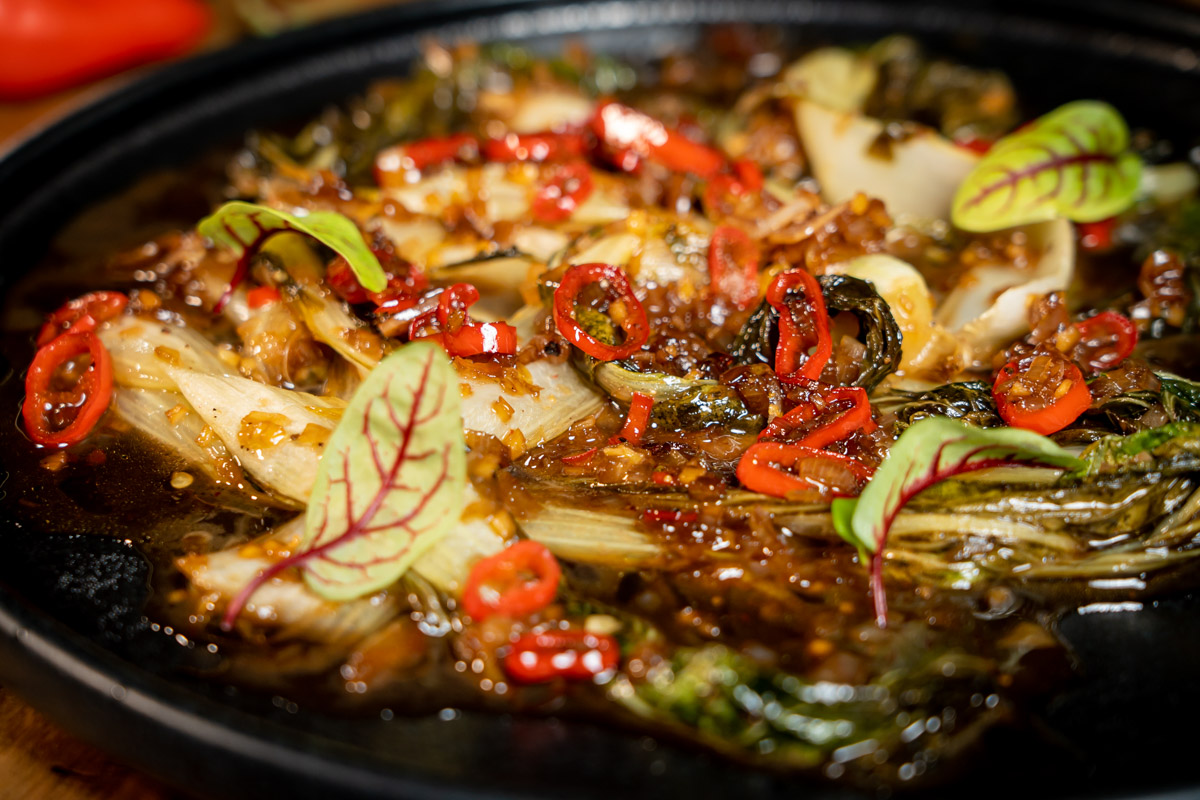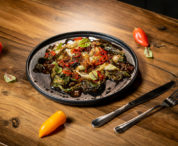Crisp and flavorful Garlic Bok Choy Recipe, ready in 35 minutes, perfect as a side dish for chicken, beef, or fish.
The elegance of this Garlic Bok Choy recipe lies in its simplicity and speed. In just 10 minutes, you can transform this humble leafy green into a vibrant, flavorful side dish that complements a variety of main courses. The combination of garlic, ginger, and soy sauce elevates the bok choy, creating a harmonious balance of savory goodness. It's a testament to the beauty of uncomplicated yet delicious recipes that grace our tables with minimal effort.
Simplicity often holds the key to life’s greatest pleasures. This recipe for Bok Choy is exactly that – simple, easy, and delicious. It’s made with just a handful of ingredients including ginger, garlic, chili pepper, shallot, and soy sauce. The best part? It only takes 10 minutes to make! All you need is a hot skillet and a spatula.
What is Bok Choy (Pak Choy)
Bok choy, also called pak choi or Chinese cabbage, is a leafy green vegetable in the Brassica family, which includes cabbage, broccoli, and kale. Resembling a cross between celery and romaine lettuce, it has thick, white stalks and dark green leaves. Bok choy is commonly used in Asian cuisine, especially Chinese, Korean, and Japanese dishes.
Bok choy has a mild, slightly sweet taste with a hint of mustard-like pungency. The stalks are crisp and succulent, while the leaves are tender and smooth. Bok choy is a versatile ingredient in many culinary preparations because it retains its crisp texture and delicate flavor when cooked.
Origin of Bok Choy
Bok choy has its origins in China, where it has been in cultivation for centuries. It is believed to have been cultivated in the Yangtze River Delta region since the 5th century AD. Over time, it spread to other parts of Asia. Eventually, it gained popularity in Western countries.

Ingredients in this Garlic Bok Choy Recipe
- Cabbage Bok Choy: The main ingredient in this dish, bok choy adds a crisp texture and a mild, slightly sweet flavor to the dish.
- Chili: Balances the other flavors and adds a touch of heat and depth to the dish.
- Garlic: Provides a savory and aromatic essence that enhances the overall flavor of the dish.
- Ginger: Provides a warm and slightly peppery flavor that complements the other ingredients and adds depth to the dish.
- Lemon: Provides a zesty and refreshing citrus flavor that brightens the dish and balances the richness of other ingredients.
- Sesame Oil: Adds a nutty and distinct flavor that enhances the overall aroma and flavor of the dish.
- Soy Sauce: Adds depth and complexity to the dish by providing a salty and savory umami flavor.
- Shallot: Provides a milder and sweeter flavor compared to onions, adding depth and complexity to the dish.
- Butter: Enhances the overall texture and flavor profile of the dish by adding richness and creaminess.
- Worcestershire Sauce: Provides a unique tangy and savory flavor that enhances the overall flavor of the dish.
- Sugar: Balances the flavors by adding a touch of sweetness, rounding out the flavor profile of the dish.
- White wine: Adds acidity and depth of flavor, enhancing the overall flavor profile of the dish and adding complexity.
How to cook bok choy?


- First, peel, wash, and dry the bok choy.
- Finely dice the onion and garlic and slice the chili.
- Heat a frying pan, add sunflower oil, and fry the bok choy for 1.5 minutes on each side, then reduce the heat and add the garlic, onion, and chili. Cook until golden brown (about 4 minutes).
- Then, add wine and evaporate it twice.
- Next, add lemon juice and zest, Worcestershire, soy sauce, and sesame oil.
- Add sugar and butter and cook over low heat until the sauce thickens (about 1.5 – 2 minutes).
Chef Recipe Tip:
- For a spicier flavor, you can add kimchi sauce or adobo sauce.

What is the difference between Bok Choy and Baby Bok Choy?
After conducting some research, I found the following information in response to several inquiries.
- They are essentially identical.
- The difference between regular bok choy and baby bok choy is that the latter is harvested earlier, resulting in smaller and more tender leaves.
- This means that baby bok choy is much sweeter than regular bok choy and is often used in soups or salads.
- Bok choy is heartier and perfect for longer cooking times, such as in stir-fries.
Bok Choy Nutrition
Bok Choy is high in nutrients. It is low in carbohydrates. When you are trying to eat more healthy, low-calorie foods, it is an excellent choice.
1 cup of raw bok choy – 1.5 grams of carbohydrates, 1 gram of dietary fiber, 9 calories
This popular green is high in fiber, vitamin C, vitamin K, vitamin A, and beta-carotene. It is also an excellent source of folate, calcium, and vitamin B6. It is also considered both a cruciferous vegetable and a leafy green.

How to Clean Bok Choy:
It’s important to clean bok choy thoroughly before cooking because it can hold a lot of dirt between the leaves. It is a good idea to quarter the bok choy lengthwise before washing, as it is much easier to clean. You can put all the pieces in a large bowl of water and swirl them to loosen the dirt, or you can rinse each piece individually under cold running water. Whichever washing method you choose, it’s important to drain and dry the bok choy before it goes into the hot pan. If you have one, a salad spinner is the quickest and most efficient way to do this.
What to serve with bok choy
One of my favorite things about this recipe is how versatile it is and how well it pairs with any dish.
- Consider adding shrimp to your meal for a high-protein and low-carb option.
- You can pair it with your preferred chicken or steak, and serve it along with a side of rice.
- Add onions, carrots, bell peppers, and broccoli to make a stir-fry full of veggies that the entire family will enjoy.
- Toss the ramen with chili sauce for a better-than-takeout meal.


Peel, wash, and dry the bok choy.
Heat a frying pan, add sunflower oil, and fry the bok choy for 1.5 minutes on each side, then reduce the heat and add the garlic, onion, and chili. Cook until golden brown (about 4 minutes).
Add wine and evaporate it twice.
Add lemon juice and zest, Worcestershire, soy sauce, and sesame oil.
Add sugar and butter and cook over low heat until sauce thickens (about 1.5 – 2 minutes).
* Percent Daily Values are based on a 2,000 calorie diet. Your daily values may be higher or lower depending on your calorie needs.
** Nutrient information is not available for all ingredients. Amount is based on available nutrient data.
(-) Information is not currently available for this nutrient. If you are following a medically restrictive diet, please consult your doctor or registered dietitian before preparing this recipe for personal consumption.
Powered by the ESHA Research Database © 2018, ESHA Research, Inc. All Rights Reserved
When cooking bok choy, ensure that the white parts are cooked to your desired level. Some prefer a crunchier texture, while others lean towards a more well-done stir-fry. To achieve this, cover the pan intermittently while cooking, allowing the bok choy to steam and soften. Experiment with the cooking time to find the perfect balance that suits your taste. Additionally, feel free to customize the recipe by adding colorful vegetables or protein sources for a delightful, well-rounded meal. Enjoy the ease and versatility of this Garlic Bok Choy recipe!







































